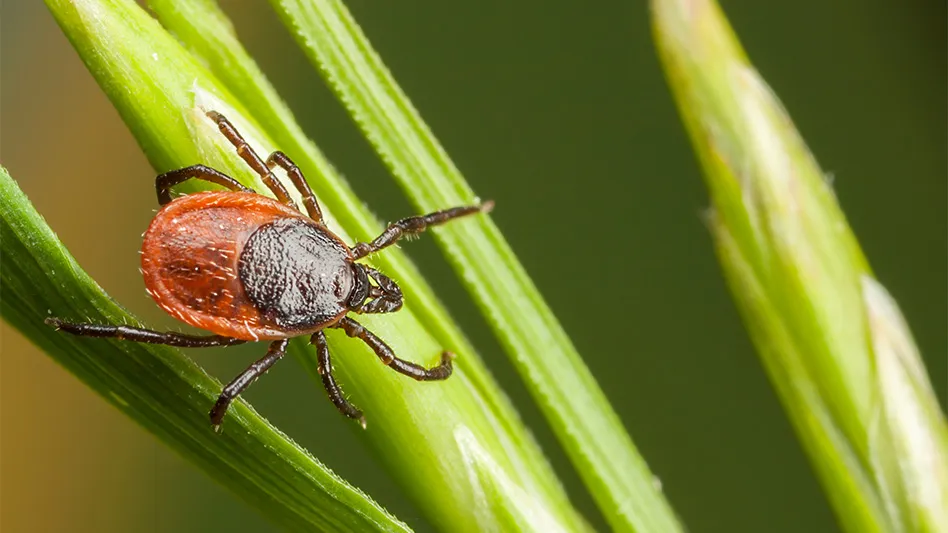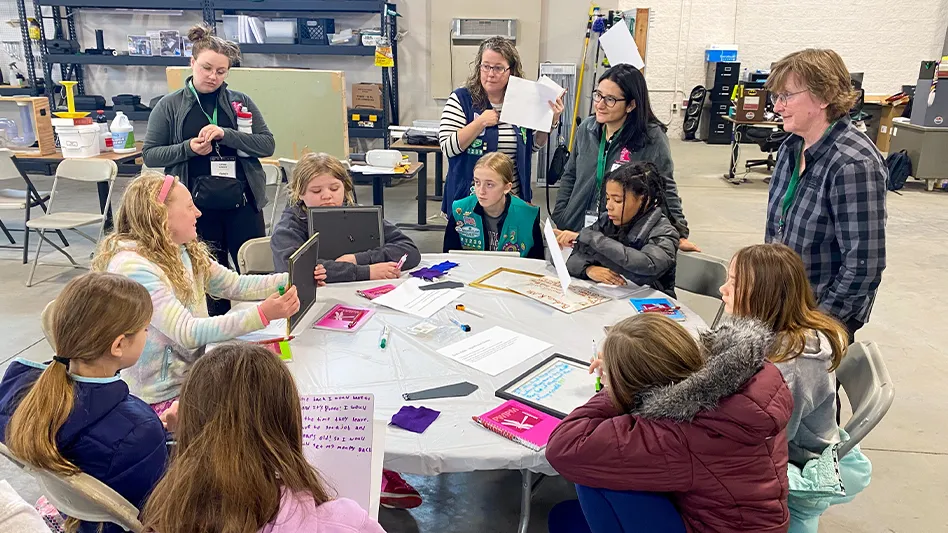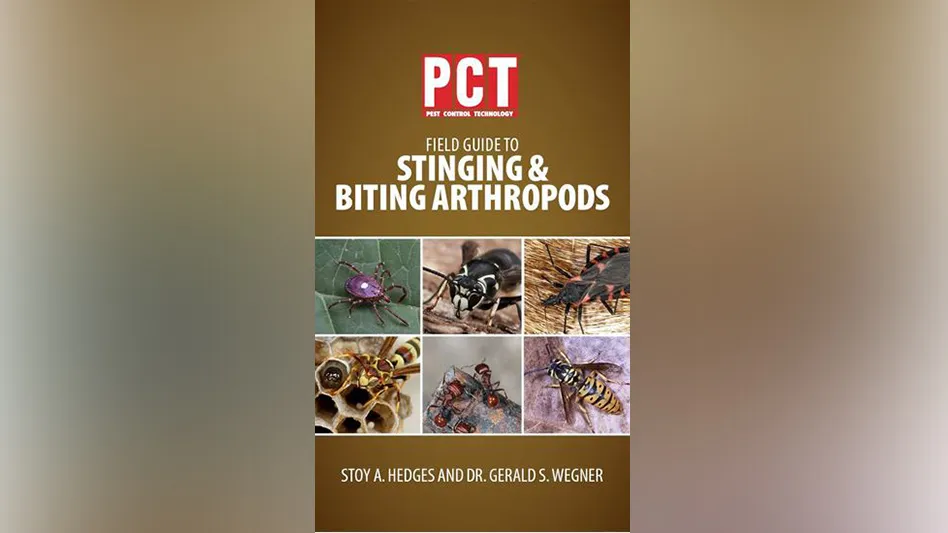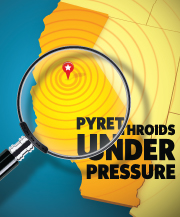 If you use pyrethroids, it’s a good bet you’ll need to change your pest management protocols.
If you use pyrethroids, it’s a good bet you’ll need to change your pest management protocols.
New federal labels are coming on line that will restrict how you apply these products.
The “common sense limitations” intend to reduce the amount of pyrethroids entering water bodies, said U.S. Environmental Protection Agency Pesticide Reevaluation Division Director Rick Keigwin, who spoke at the National Pest Management Association’s Legislative Day on Feb. 26.
Some pyrethroid products already carry the new labels; others will be introduced soon.
What Changed? The new labels contain mandatory and advisory language in two areas: environmental hazard statements and directions for use.
Environmental Hazard Statements. The new environmental hazard statement language “isn’t radically different” from previous language, said National Pest Management Association Senior Vice President Bob Rosenberg.
The mandatory statement for liquid, liquid-ready-to-use, granular and dust products is as follows:
To protect the environment, do not allow pesticide to enter or run off into storm drains, drainage ditches, gutters or surface waters.
Applicators are advised to apply the product in calm weather when rain is not predicted for the next 24 hours. Liquid concentrate users should rinse application equipment over the treated area, and broadcast granular users should sweep granules off sidewalks, driveways and streets back onto the lawn or garden to help avoid run off to water bodies or drainage systems.
“In our judgment, these changes to the label are advisory, not mandatory, and are not enforceable,” said Rosenberg.
Directions for Use. More significant are new mandatory use directions. These changes affect preconstruction termite and outdoor non-agricultural use applications.
- Preconstruction Termite
Termite pretreats will require the treatment site be covered prior to a rain event to prevent run off to non-target areas. PMPs must cover this site themselves or provide written notification to the contractor, who then becomes responsible under FIFRA, to ensure treated soil is covered with a waterproof covering (e.g., with polyethylene sheeting) if the concrete slab cannot be poured over the treated soil within 24 hours of application, or if precipitation is predicted to occur before the concrete slab is scheduled to be poured.
The new label says no treatment can be made when soil is water-saturated or frozen, or during rain. Applicators cannot apply product within 10 feet of storm drains, 25 feet of aquatic habitats, or when sustained winds at the application site are above 10 mph at nozzle end height.
- Granular
These products must be applied directly to lawn or garden areas. Treated areas should be watered as directed on the label but not to the point of runoff. Applications cannot be made during rain.
- Liquid, Dust and Ready to Use
Treated areas cannot be watered to the point of runoff, and applications cannot be made during rain.
- Products NOT Used in Drains/Sewers
Application is prohibited directly into sewers or drains, or to any area like a gutter where drainage to sewers, storm drains, water bodies or aquatic habitat can occur. Do not allow the product to enter any drain during or after application.
- Products Used in Drains/Sewers
Except as directed by the label, these products cannot be applied directly to sewers or drains, or to any area like a gutter where drainage to sewers, storm drains, water bodies or aquatic habitat can occur.
- Outdoor Surface and Space Sprays
New use directions for outdoor surface and space sprays are most likely to impact pest management professionals.
Crack and Crevice. All outdoor applications (except fogging) now are limited to spot or crack and crevice treatment. Exceptions include applications to soil or vegetation around a structure, to lawns, turf and vegetation, and to building foundations up to 3 feet high.
Applications to impervious surfaces like patios, sidewalks, driveways, porches and structural surfaces (doors, windows, eaves) are limited to spot and crack and crevice only. This is the “crux” of the new labeling language, said Rosenberg.
EPA clarified some language in an October 2011 letter to California Department of Pesticide Regulation, which is in the process of crafting more stringent state regulations (see related story, below).
It stated a building foundation does not exclude siding material, so pest management professionals can treat 3 vertical feet of foundation and siding. Spot treatment includes using a 1-inch-wide band application — called a “pin stream” application in the letter — in areas such as around windows and doors. Application to the undersides of eaves or soffits is allowed.
|
Tighter Regulations Coming in California Pest management professionals in California saw federal pyrethroid labels changes coming years ago, said Clark Pest Control Technical Director Darren Van Steenwyk. More stringent state regulations, expected to become law this summer, weren’t a surprise, either. “California always likes to out-do the federal government,” said Western Exterminator Co. President Mike Katz. Surface Water Protection Regulations proposed by the California Department of Pesticide Regulation (CDPR) are still in the draft stage. They will apply to 17 pyrethroids — the same being re-labeled by the U.S. EPA — used in pest control businesses, including maintenance gardeners. As proposed in December 2011, they will require California PMPs to apply pyrethroids according to new federal label directions regardless of the label on the product, said Van Steenwyk. This is intended to level the playing field and prevent PMPs with the financial means from purchasing (and continuing to apply) large quantities of product with the old label. In addition, PMPs will be restricted to applying pyrethroids 2 feet high, instead of the 3 feet allowed by the federal label. This change is consistent with how PMPs use pyrethroids in California, Van Steenwyk explained. As part of this process, CDPR asked EPA to clarify its label language, which it did in October 2011. “Until the law has been signed and passed” it’s hard to say what the California regulations will require, said Syngenta Brand Manager Pat Willenbrock on behalf of the Pyrethroid Working Group. The industry coalition has worked with CDPR to provide data, identify sources and develop mitigation strategies. The Pest Control Operators of California support the regulations produced to date. But, the industry doesn’t know how much is going to change moving forward, Van Steenwyk said. CDPR’s latest comment period on revisions to the proposed regulations ended March 21. California’s regulations are expected to take effect before EPA completes the process of modifying each individual pyrethroid product label. The fact some products in the marketplace already have new federal labels is adding to the confusion. More information on the proposed California regulations can be found here: www.PWG2PMP.com. — A.N. |
Outdoor Surface Sprays. PMPs using pyrethroids to control overwintering pests, spiders, backyard mosquitoes, ants, carpenter bees and occasional invaders may need to rethink treatment strategies.
“Each of these types of treatments will have their challenges,” said NPMA Technical Director Jim Fredericks in a January member webinar. Power-spraying or misting an entire structure or horizontal impervious surface, like a sidewalk or driveway, is no longer allowed.
|
The Cross Hairs: What’s Next? New label use restrictions have many pest management professionals wondering if pyrethroids eventually will suffer the same fate as organophosphates. “I don’t see any reason to believe that’s going to be the case,” said National Pest Management Association Senior Vice President Bob Rosenberg. The U.S. Environmental Protection Agency concluded a cumulative risk assessment for naturally occurring pyrethrins and synthetic pyrethroids late last year and found still “plenty of room in the risk cup,” explained Rosenberg. That is, exposures from these insecticides do not pose risk concerns for children or adults. Not everyone agrees. More than 100 national, state and local grassroots organizations criticized the agency’s assessment, saying it ignored peer-reviewed studies linking pyrethroids to a variety of health issues. On a different front, the environmental impacts of pesticides are getting more attention from regulatory bodies. “Ecological issues are being given greater weight than historically given,” said Rosenberg. “Twenty years ago, people were talking about cancer and acute risk to human beings, not the impact on aquatic and endangered species.” According to Clark Pest Control Technical Director Darren Van Steenwyk, the California Department of Pesticide Regulations requires an environmental toxicological package to register active ingredients in the state. Protecting human health is the priority, but the agency also is looking at the consequences of off-site chemical movement. — A.N. |
PMPs cannot treat 3 feet out in a perimeter application if an impervious surface (sidewalk, driveway or patio) abuts the foundation. Only crack and crevice or spot treatment, including a 1-inch-wide spray application, is permissible.
The label change is causing “lots of tension and anxiety” because it has an “impact on our application culture,” said Joe Barile, technical services lead for Bayer’s Professional Pest Management business.
Dayton Hylton, president of Dayton’s Pest Control, Knoxville, Tenn., said the label change will cost him between $200,000 and $400,000 in annual income.vHis technicians “paint” houses from ground to eaves with pyrethroids using mist blowers to protect against fall invaders and carpenter bees. About 400 customers pay a premium for the service. It’s the most effective way to provide a continuous barrier, especially for cabins located in the country. Being limited to a 1-inch pin stream application, he said, is unrealistic.
“When traveling 30 to 50 miles to a mountain or lake cabin for carpenter bees and ladybugs, spot treating is a waste of time and is completely ineffective,” Hylton said. He added caulking doesn’t work, either.
Hylton fears he won’t be able to guarantee service. Or, technicians will need to make more frequent service visits. “I’m frustrated,” he said.
Bill Kirchner, owner of Cleveland Chemical in Cleveland, Ohio, said his annual business could take a 20 percent hit. He questioned treatment effectiveness if his team can’t power spray houses for spiders, stinging insects and overwintering pests. “How are you going to treat a three-story house, with a hand tank?” he asks.
He said the new regulations will require more material and time. In the end, “it’s the customer who pays.”
What You Need to Do. PMPs need to stay in compliance regarding their pyrethroid use. Here’s what your firm needs to do:
Read the Label. This is “particularly important” with every product in a different phase of label change, said Syngenta Brand Manager Pat Willenbrock on behalf of the industry-funded Pyrethroid Working Group. EPA must approve each product label individually, so there’s no one date when all pyrethroid labels will switch over.
EPA didn’t impose a deadline on when existing stock had to be exhausted, said Keigwin. Applicators can continue using products with old labels, but must change practices once that product bears the new label.
Instruct technicians to compare labels on every container, advised Barile. The risk of an employee picking up a newly labeled product and applying it by old use directions is very real. “The obligation every applicator has is to the follow the label the product,” he said.
Manage Existing Stock. Rosenberg suggested PMPs may want to manage existing stock with old labels wisely.
Stockpiling product is not a long-term solution from a cost or practice standpoint, said Barile. Theoretically, EPA could recall all old-label pyrethroids if it found applicators were hoarding them, Rosenberg said.
Learn More. Look to local and state associations, distributors and manufacturers for insights.
“Education is a big part of what we supply,” said Univar Marketing Director Karl Kisner. Univar has a label change summary on its PestWeb site, and sales reps are holding customer meetings to explain the changes. Distributors also can help identify treatment alternatives, he said.
PWG is actively reaching out. A new website, PWG2PMP.com, lets PMPs sign up for e-mail alerts and notifications from regulatory authorities, as well as access articles and frequently asked questions.
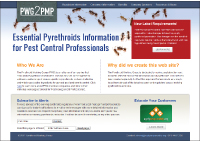 The Pyrethroid Working Group is an alliance of firms that manufacture pyrethroid insecticides. Visit www.pwg2pmp.com to keep abreast of pyrethroid regulatory news. The Pyrethroid Working Group is an alliance of firms that manufacture pyrethroid insecticides. Visit www.pwg2pmp.com to keep abreast of pyrethroid regulatory news. |
Individual member companies are holding training seminars for user groups, state associations and customers, as well as sending letters outlining specific label changes and timing.
PMPs have been “using these products for a long time so we want to be sure they are aware of these changes as they occur,” said FMC Global Stewardship Manager Linda Froelich for the industry group.
Adjust Business Practices. PMPs must take steps to address use patterns, said Clark Pest Control Technical Director Darren Van Steenwyk in Lodi, Calif.
Clark Pest Control has been holding classroom and in-field training, and evaluating the large-scale implementation of alternative chemistries and service protocols. “As a company we’ve had to learn how to use new products. We’ve also had to re-learn how use pyrethroids,” he said.
Western Exterminator Co., in Anaheim, Calif., started training last year and will continue to train as more labels switch over, said President Mike Katz. The company uses “job aids” to remind technicians of regulations and use restrictions. Technicians review these cards or electronic hand-held documents before using certain products or performing specific jobs. “There are so many things now technicians need to know. We try to provide as much information in easy-to-use formats as possible.”
Giving some customers what they want — product dripping from the eaves or a wet driveway — is now a legal, fine-able offense, reminded Van Steenwyk. Pest management professionals will “need to find a new way of meeting those needs.”
Much of the new label language “requires us to do what we’ve been preaching about for a long time anyway,” said Rosenberg.
Mark Boyd, president of Control Solutions, suggested PMPs stay abreast of new products coming on the market. Cisse Spragins, CEO of Rockwell Labs, suggested using non-pyrethroid granular baits.
But switching chemistries isn’t always a simple fix. There really aren’t substitute chemistries that can replace pyrethroids in terms of efficacy and convenience, said Barile.
Plus, if use patterns and non-discriminatory pesticide applications don’t change, the industry will have the same conversation about a different chemistry down the road, Van Steenwyk said.
MGK Technical Service Manager Chris Swain, who used to operate his own pest management firm in College Station, Texas, said PMPs who power spray structures may need to build more time into jobs to conduct more accurate applications.
“This kind of change forces you to get innovative,” said Katz. He’s confident Western Exterminator Co. will develop effective ways to meet customer expectations and stay in compliance. “We’ve always been pretty good at doing that.”
|
How Did We Get Here? Pyrethroids became go-to products after organophosphates, like chlorpyrifos and diazinon, were taken off the market in 2001 and 2004. Since then, the chemicals have been found to cause significant impairments to water bodies, as defined under the U.S. Clean Water Act.
More states will be added to this list when two studies by the U.S. Geological Survey are published later this year. One research project tracked pyrethroids in stream sediment in seven major metropolitan areas: Denver, Dallas/Ft. Worth, Boston, Seattle/Tacoma, Salt Lake City, Atlanta and Milwaukee. The second study monitored urban and agricultural areas in 25 states. The chemicals also have been found in the water itself. A 2010 report by Dr. Don Weston of University of California at Berkeley, and Dr. Michael Lydy of Southern Illinois University discovered pyrethroids in street runoff, sewage treatment outflow and a major river in Sacramento. All studies found pyrethroids at levels toxic to the crustacean Hyalella azteca, a small shrimp-like organism used to study water quality. The species is paralyzed and killed at pyrethroid levels of two parts per trillion. It is the “canary in the coal mine,” said Bob Rosenberg, senior vice president of the National Pest Management Association. If pyrethroids impair this organism, scientists believe other organisms in the ecosystem may be affected. Early study results spurred the California Department of Pesticide Regulations to re-evaluate pyrethroids in 2006. About the same time, the U.S. Environmental Protection Agency began re-evaluating seven pyrethroid active ingredients registered before 1984 as part of its routine re-registration program. The agency is required by law to re-evaluate pesticides every 15 years. EPA was made aware of pyrethroid residues in urban and residential water bodies through water monitoring data and public comments submitted to the agency from interested parties during reregistration. The first indication label language might change occurred during the re-evaluation of cypermethrin in 2006, said Rosenberg. To address concerns coming out of California, EPA proposed “fairly substantial but impractical mitigation language,” but instead decided to step back and address pyrethroids more comprehensively, he said. The agency also was seeking advice on how to make pyrethroid labels easier to understand and follow for consumers and PMPs. “Given the issues we were finding in some of the urban areas, we thought pyrethroids as a class would be a good group of products to apply lessons learned from the Consumer Labeling Initiative,” said Rick Keigwin, director of the agency’s Pesticide Reevaluation Division at NPMA’s Legislative Day in February. The agency moved up re-registration of remaining active ingredients, a process expected to last through September 2012. EPA issued a PR-Notice in 2008 to change pyrethroid environmental hazard statements to better protect aquatic habitats and the environment. In June 2009, it requested registrants change label use directions. In September 2010, EPA began approving individual product labels. Manufacturers were given 18 months to begin putting them on newly made products. In California, new surface water protection regulations imposing stricter pyrethroid use directions should become law this summer. — A.N. |
Get and Give Input. Pest management professionals should confer with state regulators to learn how the new labels will be interpreted and enforced. Make sure state lead agencies are aware of EPA’s clarification to the California Department of Pesticide Regulations, advised Rosenberg.
“It’s not obvious to me that states other than California were directly involved in the development of this language” so other state agencies have an educational process to go through as well.
Barile caught a few state regulators by surprise during a state recertification presentation. In some cases the mandate has not been communicated well from the federal level down to the people who will be enforcing it at the state level, he said.
Kirchner is waiting on the Ohio Department Agriculture’s take on the label language. Even with the CDPR interpretation, the wording is vague, he said. What is considered an outdoor spot treatment? What is a 1-inch pin stream?
The Ohio and Florida Departments of Agriculture and several pest management companies recently asked for clarification of certain statements and timing, EPA reported.
“If you have a specific use pattern that you think is critical, we’ll engage in that conversation,” said EPA’s Keigwin. He urged PMPs to work through state and national associations.
NPMA’s Government Affairs Committee recently formed a group to give PMPs a clear voice in reviewing, refining and adopting revised label language.
“By the end of 2012 I think we’re going to have a very clear picture on what the real compliance requirements are going to be for this particular issue, and they may not be nearly as bad as we thought,” said Barile.
Why Changes Must Work. Some PMPs fear the more restrictive labels are the first step in a total ban on pyrethroids.
That’s exactly what will happen in California if new labels and regulations don’t work, said Van Steenwyk, who’s worked closely with CDPR on behalf of Pest Control Operators of California. He said CDPR has stated if pyrethroids continue to move off site, further restrictions will happen.
“That’s when it gets really bad,” he said. If you think restrictions make treatment difficult, consider what happens if you can’t use them at all, he added.
CDPR will evaluate pyrethroid levels three to five years after regulations take effect to determine if they achieved their goals. If not, it’s questionable whether the agency will ask for further industry input on the matter, said Van Steenwyk.
EPA will consider new water monitoring data in future ecological risk assessments. If data show acute or specific risks, the agency can require label changes and amendments before pyrethroids undergo their next registration review cycle in 15 years.
“These regulations and label changes will protect the longevity of these products,” said Van Steenwyk. If they work, they’ll keep pyrethroids on-site and out of water, which means future restrictions will be unnecessary.
Control Solutions’ Boyd says the label changes and new products being introduced will prove effective in protecting surface waters. Rockwell Labs’ Spragins isn’t so sure. “Time will tell,” she said.
PWG is “pretty optimistic” the new labels will work, said Willenbrock. Preliminary research indicates they will have a positive impact. The group has spent $10 million in research over the past three years.
Pest management professionals aren’t the only ones facing pyrethroid use restrictions. Consumer and agriculture products face similar scrutiny. They’re just in different phases of the process, said Willenbrock.
The EPA labeling initiative affects more than 2,000 end-use pyrethroid products. The agency believes the new language will help PMPs and homeowners better understand how to use products to minimize environmental hazards.
The changes are “really making us be better stewards,” said MGK’s Swain.
From a sustainability perspective, it’s important to have good resources for future generations, added Froelich. “The environment is an important piece of that.”
“We’re always going to adapt,” said Cleveland Chemical’s Kirchner of the challenge ahead.
The author is a frequent contributor to PCT magazine. She can be reached at anagro@giemedia.com.
Learn More
U.S. EPA
www.epa.gov/oppsrrd1/reevaluation/environmental-hazard-statment.html
View new pyrethroid label language — environmental hazard statements and directions for use — by clicking the “Label Table” link. Also posted: The California Department of Pesticide Regulation’s Aug. 4, 2011, request for language clarification, and the agency’s Oct. 25, 2011, response.
California Department of Pesticide Regulation
www.cdpr.ca.gov/docs/legbills/rulepkgs/11-004/11-004.htm
Follow the status of proposed California surface water regulations.
Pyrethroid Working Group
www.pwg2pmp.com
Monitor federal label changes and proposed California surface water regulations. Sign up for e-mail alerts, view regulatory documents and access frequently asked questions.
National Pest Management Association
www.npmapestworld.org/publicpolicy/Pyrethtroids.cfm
View a webinar on the federal label changes and learn how they may affect your existing use patterns. Get links to groups involved in this process.
Contact your distributor or manufacturers. Many have collateral materials outlining the changes and are hosting meetings for associations, user groups and recertification programs. — A.N.
|
Time to Refine Your Protocols
Individual labels carry specific use directions, but here are some general changes likely to impact the industry:
Source locations are where pests feed, breed and harbor around the perimeter, such as in mulch beds, organic debris, landscape features like railroad ties or structural voids. Interception points occur between the source location and the areas PMPs are trying to protect. These might be entry points under siding edges, around windows and doors, and where utility lines enter the structure. Also look for likely travel routes, such as cracks in patios and sidewalks, and treatable areas along the edges of impervious surfaces. Overwintering and Invasive Pests. With whole-house applications of pyrethroid by power sprayer or mist blower no longer allowed, treating invasive and overwintering pests will require new tactics. Fredericks suggested applying pyrethroid to:
Fredericks said PMPs shouldn’t overlook exclusion methods, which may be difficult to employ but are effective. Physical controls can reduce populations. He mentioned one PMP who vacuumed overwintering pests off a customer’s home.
PMPs can continue to treat many source locations, like soil, mulch, grass and vegetation with liquid and granular pyrethroids, as well as use baits. Just do so in compliance with new environmental hazard language, he advised. PMPs can treat 3 feet up the foundation. He suggested crack-and-crevice applications for under siding edges and where utility lines enter the structure. Ants will travel along the edge of a walkway, he reminded. Identify these travel routes, and treat the mulch or grass bordering an impervious surface. Sidewalk, patio and driveway cracks can be spot or crack-and-crevice treated. Retrain technicians so they don’t continue the practice of treating the junction between the garage door and driveway, he said. You also may need to reconsider spraying the front door threshold or window sills if the area is greater than a 2-foot by 2-foot spot.
He suggested a crack-and-crevice approach for under siding edges; spot treating harborage sites; and applying a perimeter band to soil, mulch, vegetation or grass to control ground-dwelling spiders. In Anaheim, Calif., Western Exterminator Co. technicians remove spiders and webs using a brush on a long pole, said President Mike Katz. This has allowed the company to “minimize the amount of material we’re going to use while giving customers the results they want.”
He suggested PMPs first survey the property to identify potential or existing mosquito breeding locations, such as where water collects in children’s toys, tire swings, bird baths, pet bowls, flower pots and rain gutters due to clogged downspouts. Work with clients to eliminate these conditions. Second, apply an insect growth regulator to interfere with mosquito larvae development in areas where standing water cannot be eliminated. Finally, apply an appropriately labeled insecticide to adult mosquito resting places, such as vegetation and landscaping. Application also can be made to areas under the eaves and spots around doors and windows.
|
More Regulatory News: EPA Revises RRMD for Professional Products
In March, the U.S. Environmental Protection Agency announced important revisions to rodenticide labels that provide pest management professionals with much needed flexibility to manage rodent infestations. Specifically, the new label language:
- Extends the distance from which rodenticides can be placed from buildings from 50 feet to 100 feet and replaces the word “building” with the term “man-made structures” (Note: the phrase “man-made structures” is broadly defined, however, it expressly excludes “fence and perimeter baiting, beyond 100 from a structure…”).
- Permits the use of first-generation anticoagulant and non-anticoagulant professional products to treat burrows that are further than 100 feet from buildings and man-made structures.
Background. In 2008, EPA released the Rodenticide Risk Mitigation Decision (RRMD). Included in this decision was a label revision for second-generation anticoagulant rodenticide products that stated “all outdoor above ground use must be in a bait station and be applied within 50 feet of buildings.” The problem with this restriction, as many pest management professionals voiced, was that this label revision would have gone against the standard practice of establishing a perimeter in order to push the rodent population as far away from the building, structure or site as possible. For example, PMPs will ask their clients to place Dumpsters and trash receptacles and their associated attractants as far away from the building, structure or site to help reduce the possible build up of rodent and insect pest populations next to the building.
Collaborative Effort. The National Pest Management Association (NPMA) and the Association of Structural Pest Control Regulatory Officials (ASPCRO) encouraged EPA officials to revise the label language to provide for more flexibility.
.jpg) ASPCRO President Derek Lastinger told PCT that ASPCRO’s decision to encourage EPA for the label revisions came after it surveyed the states – and talked to pest management professionals – about the RRMD. “We had concerns from both the states and the industry about how this would affect the way rodents would be managed,” Lastinger said. “It was at this point we started conversations with EPA.”
ASPCRO President Derek Lastinger told PCT that ASPCRO’s decision to encourage EPA for the label revisions came after it surveyed the states – and talked to pest management professionals – about the RRMD. “We had concerns from both the states and the industry about how this would affect the way rodents would be managed,” Lastinger said. “It was at this point we started conversations with EPA.”
Mike Katz, president of Western Exterminator Co., Anaheim, Calif., said ASPCRO’s involvement was crucial. “You have to look at it from EPA’s point of view. When EPA gets the same feedback from regulatory people that they get from [industry] it gives EPA a reason to stop and consider. NPMA and ASPCRO brought forth reasonable requests and EPA was open-minded to work in good faith.”
Reaction. Industry professionals contacted by PCT were pleased that EPA made these revisions and, in general, believe the new labels will be “workable.”
Richard Berman, technical director of Waltham Services, Waltham, Mass., said extending the distance from 50 feet to 100 feet is important. “I think [the EPA revision] is a great improvement. We do most of our work in urban areas and I can’t imagine a situation where we would need to bait more than 100 feet out,” he said. “Even for those who do work in rural or farm areas, where they might have been more impacted by the 50-foot distance, I think this will significantly help.”
As Katz noted, “The further you can push back the first line of defense, the better.”
NPMA Senior Vice President Bob Rosenberg said replacing the word “building” with the term “man-made structures” is important because it allows pest management professionals “to place baits in the many thousands of man-made structures irrespective of where they are located.”
Berman agreed, adding, “We see a lot of Dumpsters surrounded by a structure that contains three concrete walls and a gate, for example, so it was encouraging that EPA listened and responded.”
Ted Bruesch, technical manager, Liphatech, said the industry “didn’t get everything we wanted,” but the revision was a great improvement. “For decades we’ve been trying to get restaurants and food plants to move Dumpsters away from the building, and then as soon as we accomplished that we couldn’t treat them. The EPA revision helps greatly.”
Mark Westover, vice president of global sales for Bell Laboratories, added, “This change goes a long way to better address the needs of PMPs and allows them to provide a more thorough and effective service.” — Brad Harbison
|
Update: EPA Clarifies Revision On March 20, less than one month after EPA revised its 2008 RRMD for Professional Use Products, the Agency provided additional clarification relating to the use of first- and second-generation anticoagulants and non-anticoagulants applied to rodent burrows. EPA specifies that the following language should appear on the revised labels:
|
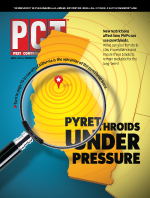
Explore the April 2012 Issue
Check out more from this issue and find you next story to read.
Latest from Pest Control Technology
- Viking Pest Control Organizes a Charity Bike Build for Local Families
- Gaining Control of Structure-Infesting Carpenter Ants
- Big Blue Bug’s Brian Goldman Receives Rhode Island Small Business Person of the Year Award
- UF Researchers Examine How Much Bait it Takes to Eliminate a Subterranean Termite Colony
- Women in Pest Control Group Continues to Grow, Provide Opportunities in the Industry
- NPMA Announces Results of 2024-2025 Board of Directors Election
- Massey Services Acquires Orange Environmental Services
- Hawx Pest Control Wins Bronze Stevie Award for Sustainability
 University studies have identified pyrethroids in the sediment of urban streams in California, Texas, Illinois, Oregon and Washington.
University studies have identified pyrethroids in the sediment of urban streams in California, Texas, Illinois, Oregon and Washington. Pest management professionals may need to adjust treatment practices in light of new federal pyrethroid labels.
Pest management professionals may need to adjust treatment practices in light of new federal pyrethroid labels.